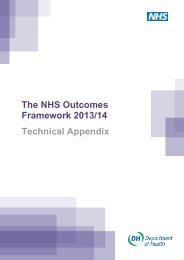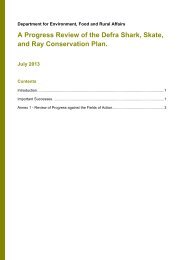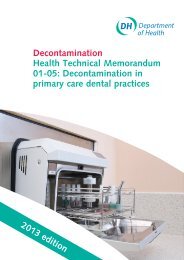A study of Patent Thickets (1.31Mb) - UK Intellectual Property Office
A study of Patent Thickets (1.31Mb) - UK Intellectual Property Office
A study of Patent Thickets (1.31Mb) - UK Intellectual Property Office
You also want an ePaper? Increase the reach of your titles
YUMPU automatically turns print PDFs into web optimized ePapers that Google loves.
56 A Study <strong>of</strong> <strong>Patent</strong> <strong>Thickets</strong><br />
In the last column we interact the log <strong>of</strong> assets with the log <strong>of</strong> patents and the log <strong>of</strong> triples<br />
density to see whether these effects vary by size. 36 They do, and in the expected way. The<br />
impact on larger firms from aggregate patenting weakens and the impact <strong>of</strong> triples strengthens<br />
slightly. That is, the impact <strong>of</strong> both aggregate patenting (positive) and triples density (negative)<br />
on SMEs is stronger than it is for larger firms. We show this graphically in Figure 13, which<br />
overlays the coefficients <strong>of</strong> aggregate patenting and triples density as a function <strong>of</strong> firm size on<br />
the actual size distribution <strong>of</strong> our firms. From the graph one can see that the impact <strong>of</strong> aggregate<br />
patenting in a sector is higher and more variable than the impact <strong>of</strong> the triples density. Firms in<br />
the lower range <strong>of</strong> the size distribution (assets less than 10,000 pounds) are much more likely<br />
to enter a sector with high aggregate patenting if they enter at all, but their hazard <strong>of</strong> entry falls<br />
15 per cent if the triples density doubles in that sector. On the other hand, for the few firms in<br />
the upper range <strong>of</strong> the size distribution (assets greater than 100 billion pounds), the hazard <strong>of</strong><br />
entry falls only 7 per cent if the triples density doubles.<br />
1.0 <br />
20,000 <br />
0.8 <br />
0.6 <br />
18,000 <br />
16,000 <br />
14,000 <br />
Coefficient <br />
0.4 <br />
0.2 <br />
12,000 <br />
10,000 <br />
8,000 <br />
Number <strong>of</strong> firms <br />
0.0 <br />
6,000 <br />
-‐0.2 <br />
-‐0.4 <br />
0.001 <br />
0.003 <br />
0.007 <br />
0.02 <br />
0.05 <br />
0.15 <br />
0.40 <br />
1.1 <br />
3.0 <br />
8.1 <br />
22 <br />
60 <br />
Firm assets (millions <strong>of</strong> GBP) <br />
163 <br />
442 <br />
1203 <br />
3269 <br />
8886 <br />
24155 <br />
65660 <br />
178482 <br />
Number <strong>of</strong> firms Aggregate patenng coefficient Triples density coefficient <br />
Estimated coefficients as a function <strong>of</strong> firm size<br />
4,000 <br />
2,000 <br />
We also simulated the effect <strong>of</strong> reducing the log <strong>of</strong> the triples density by one standard deviation.<br />
Because the triples density has a wide range (0.0002 to 0.2407), a one standard deviation<br />
reduction in the log is quite large and corresponds to reduction the density fivefold). Figure 13<br />
shows the corresponding increase in entry hazard by technology class. It is clear that entry into<br />
patenting increases greatly in those technologies where there are a large number <strong>of</strong> triples per<br />
patent: Telecommunications, Computer technology, Audio-visual technology, Digital<br />
communications, Semiconductors, etc.<br />
0 <br />
36 Note that all the variables have been centered at their means, so that the coefficients on the non-interacted<br />
variables are coefficients at the mean <strong>of</strong> the data and can be compared across the columns directly.

















